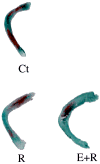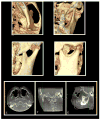TMJ disorders: future innovations in diagnostics and therapeutics
- PMID: 18676802
- PMCID: PMC2547984
TMJ disorders: future innovations in diagnostics and therapeutics
Abstract
Because their etiologies and pathogenesis are poorly understood, temporomandibular joint (TMJ) diseases are difficult to diagnose and manage. All current approaches to treatments of TMJ diseases are largely palliative. Definitive and rational diagnoses or treatments can only be achieved through a comprehensive understanding of the etiologies, predisposing factors, and pathogenesis of TMJ diseases. While much work remains to be done in this field, novel findings in biomedicine and developments in imaging and computer technologies are beginning to provide us with a vision of future innovations in the diagnostics and therapeutics of TMJ disorders. These advances include the identification and use of local or systemic biomarkers to diagnose disease or monitor improvements in therapy; the use of imaging technologies for earlier and more sensitive diagnostics; and the use of biomedicine, biomimetics, and imaging to design and manufacture bioengineered joints. Such advances are likely to help to customize and enhance the quality of care we provide to patients with TMJ disorders.
Figures








References
-
- LeResche L. Epidemiology of temporomandibular disorders: implications for the investigation of etiologic factors. Crit Rev Oral Biol Med. 1997;8:291–305. - PubMed
-
- Gelb H, Bernstein IM. Comparison of three different populations with temporomandibular joint pain-dysfunction syndrome. Dent Clin North Am. 1983;27:495–503. - PubMed
-
- Rieder CE, Martinoff JT. The prevalence of mandibular dysfunction. Part II: A multiphasic dysfunction profile. J Prosthet Dent. 1983;50:237–44. - PubMed
-
- Rieder CE, Martinoff JT, Wilcox SA. The prevalence of mandibular dysfunction. Part I: sex and age distribution of related signs and symptoms. J Prosthet Dent. 1983;50:81–8. - PubMed
-
- Dworkin SF, LeResche L. Research diagnostic criteria for temporomandibular disorders: review, criteria, examinations and specifications, critique. J Craniomandibular Disorders. 1992;6:301–55. - PubMed
Publication types
MeSH terms
Substances
Grants and funding
LinkOut - more resources
Full Text Sources
Medical
